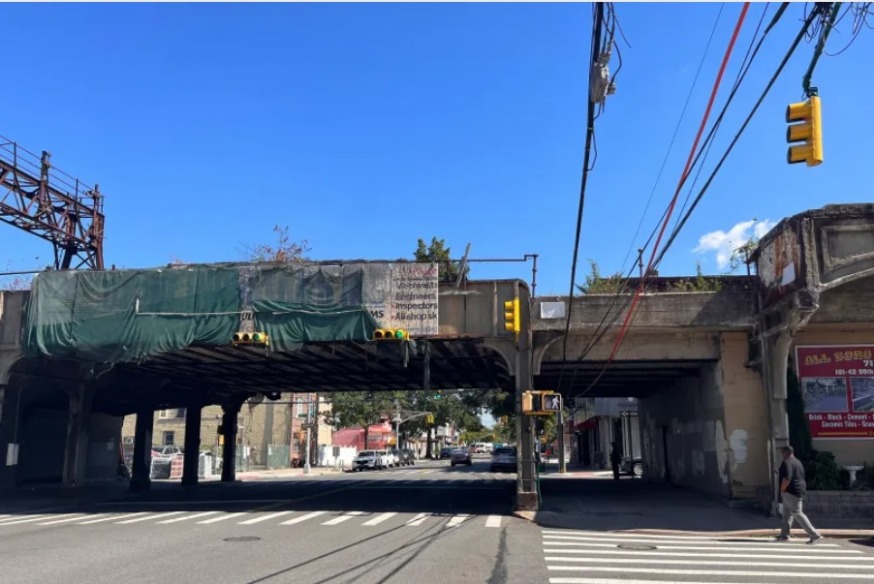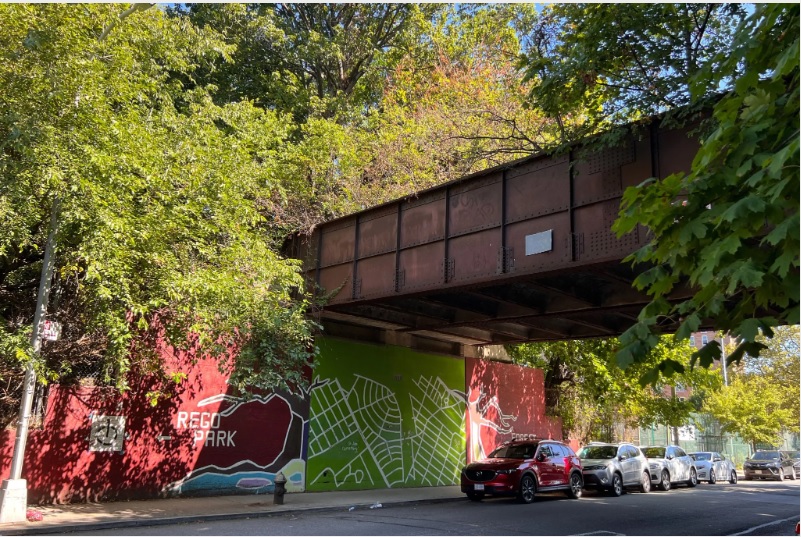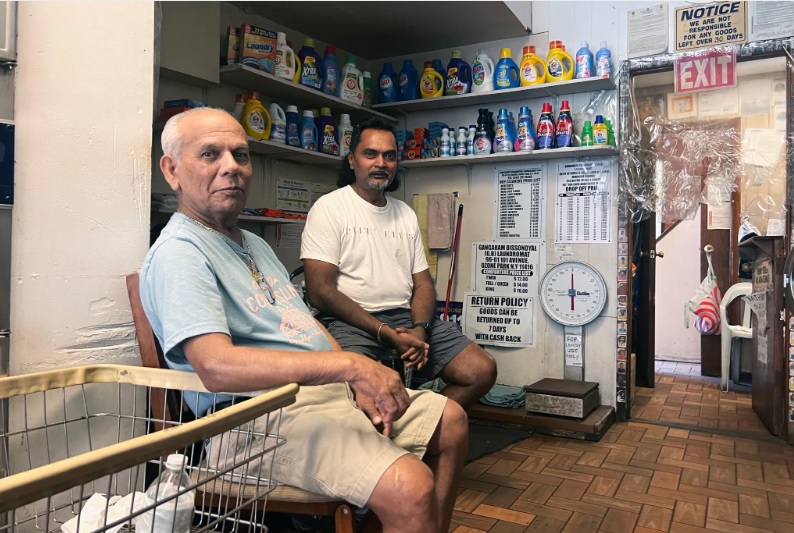
Longtime boosters of restoring rail service to a 3.5-mile stretch of the LIRR’s abandoned Rockaway Beach Branch said last week’s QueensWay park announcement left them wondering about the prospects for their preferred transit project. Photo: The abandoned, elevated railway passes through Ozone Park’s Little Guyana.Haidee Chu/THE CITY

This article was originally published by The CITY on Sept. 22
Last month, more than a dozen elected officials pressed the city and state to revive a long-dormant stretch of rail line in Queens as a subway extension.
Last week, some of those same officials stood alongside Mayor Eric Adams as he unveiled plans to put $35 million into design and construction of the first phase of QueensWay Metropolitan Hub, a High Line-like greenspace on that same stretch of tracks between Ozone Park and Rego Park.
“The fact that it’s ready to go is compelling to the Adams administration and to the community,” said Carter Strickland of The Trust for Public Land, which has pushed to transform the space into parkland. “They don’t have to wait around 60 years for a greenway, they can have it much, much sooner.”
The latest twist in the long-running saga of a railway that hasn’t had trains on its tracks since 1962 left supporters of reviving the Long Island Rail Road’s old Rockaway Beach Branch for mass transit miffed — but City Hall and MTA officials insist that reactivating the old railway is still possible.
“We are confident that what the city is doing is not going to preclude transit reactivation,” Janno Lieber, the MTA chairperson and CEO, told THE CITY Wednesday. “And we are going to work with them to make sure that that’s the case.”
Advocates for restoring train service to the line said they were caught off guard by City Hall’s support for turning the publicly owned former rail corridor into a five-acre park with nearly a mile of greenways.
“This is like putting in the landscaping and then thinking about building the house,” said Rick Horan, executive director of QueensLink, a nonprofit organization formed in 2015 to advocate for restoring train service along the 3.5 miles of dilapidated track between the A and M subway lines. “It’s crazy.”
‘A Viable Option’
The reactivation of the Rockaway Beach Branch is among the potential expansion and enhancement projects that will be covered in the MTA’s 20-Year Needs Assessment for 2025-2044. Others include a new stop on the No. 7 line at 41st Street and 10th Avenue in Manhattan, extending the Second Avenue Subway south of 72nd Street and improving transit options along Utica Avenue in Brooklyn.
As part of that document, due in the fall of 2023, the MTA is evaluating cost, ridership, equity and other factors to determine the future prospects of various transit projects.
The Rockaway Beach Branch proposal also appeared in the agency’s 20-year needs wishlist for 2015-2034, which cited the possibility of “utilization of abandoned or underutilized Rights of Way, such as the LIRR Bay Ridge Branch or the abandoned Rockaway Beach Branch.”

Abandoned, elevated railroad tracks cross over a residential road in Rego Park.Haidee Chu/THE CITY
The Bay Ridge Branch — an existing freight train line which runs between Brooklyn and Queens — is now being looked at by the MTA for potential passenger rail or bus rapid transit use as part of the proposed Interborough Express that could provide service from Bay Ridge in Brooklyn to Jackson Heights, Queens..
Gov. Kathy Hochul in January put her support behind the so-called IBX, whose initial ridership is projected to be between 74,000 and 88,000 weekday riders.
“Let’s get more transit out of our existing facilities,” Lieber said at Wednesday’s MTA board meeting. “That’s what we love about this project.”
But longtime boosters of restoring rail service to the Rockaway Beach Branch said last week’s QueensWay park announcement left them wondering about the prospects for their preferred transit project.
Phillip Goldfeder, a former Queens assemblymember who pushed for reactivation of the line from 2011 to 2016 during his terms in Albany, pointed to studies that have said new transit service is a realistic option, albeit one with a big price.
“A greenway would be lovely if the opportunity to put transportation were off the table,” Goldfeder told THE CITY. “But there have been multiple studies showing that rail is still a viable option for the old rail line and should be the number one focus for Queens and the growth of New York City.”
Those include a 2018 planning and feasibility study for the MTA — which the transit agency released in 2019 after THE CITY inquired about its existence. That review estimated that restoring LIRR service would cost at least $6.7 billion while connecting the tracks to the subway could cost $8.1 billion.
“I’d like to compare that to the future potential economic growth and activity across New York City because of the rail line,” Goldfeder said. “The most valuable asset to any transit system is its right of way and the idea that we’re doing away with that is terrible.”
Strickland, of The Trust for Public Land, said the proposed greenway would provide access to seven subway lines as well as the Long Island Rail Road, but acknowledged the divided opinions that accompany such projects
“There is always community concern about anything new being built in or near communities before it’s built,” he said. “Once it happens, there is universal acclaim, they realize there is an amazing asset right next to their homes.”
An Adams spokesperson indicated Thursday that City Hall expects the results of an MTA environmental review next year, before design of the QueensWay Metropolitan Hub is finalized.
Should the MTA want to pursue reactivating the rails, the spokesperson said, the city can adapt the design of the elevated park piece of the project.
Quiet, Please
Horan, of QueensLink, charged that the city’s support for the parks plan was “baked in NIMBYism,” referring to the Not In My Back Yard movement, and several residents who live near the abandoned railway did say they would prefer trains not return.
“This is a quiet neighborhood, you know?” said Rosana Sequeira, who lives in a Rego Park low-rise apartment building that overlooks part of the tracks. “The way things are, we’d rather not have a train nearby.”
Teddy Chan, who was at The Painter’s Playground off Alderton Street, said he does not oppose integrating new trains to the area, but would prefer having greenspace in which his 1-year-old grandson could play.
“If I were to pick, of course, I’d rather build a park,” Chan, 62, said in a mix of English and Cantonese. “The parks around here are so small — it’s not like the big ones over there in Middle Village, and Forest Park is far away.”
Closer to the Ozone Park end of the line, there was more appreciation for another transit option as residents complained about long commutes and wait times for buses.
Rohan Bisunlel, who owns a laundromat on 101st Avenue near the old elevated railway, said the area could use additional transit.
“We’re always thinking about that — that we’re gonna get back a new track,” he said Wednesday afternoon. “This time [of day], you have to wait for 45 minutes, and sometimes half an hour for the bus.”

Rohan Bisunlel sits with a friend in his laundromat on 101st Avenue in Little Guyana.Haidee Chu/THE CITY
Queens Borough President Donovan Richards, said “it’s not one way or the other” on whether a park or a transit project should be favored.
“We should be looking at ways to expand transportation and open space,” Richards told THE CITY. “They both go hand in hand.”
Officials have pointed to projects such as Atlanta’s Beltline, which turned 22 miles of unused rail line into trails, greenspace and housing — yet still includes plans to potentially add light rail.
A feasibility study earlier this year, however, found that putting light rail along a segment of the Beltline could be far pricier than initially projected.
Lieber acknowledged that any rail reactivation along the Rockaway line has “got a ways to go.”
“So I don’t want to blame the city for trying to move forward with its vision,” he said. “And we will work with them to make sure that we preserve optionality for a future transit use as best we can.”
THE CITY is an independent, nonprofit news outlet dedicated to hard-hitting reporting that serves the people of New York.
One Comment

Failure to include the Queens Link transit project in the upcoming MTA 2025 – 2044 Twenty Year planning document would end any hope of advancement regardless of finding future funding for any EIS. Should the MTA & LIRR agree to be project sponsors, their next step would be to obtain permission from the Federal Transit Administration to enter this project under the FTA national competitive discretionary Capital Investment Grants (CIG) New Starts Core Capacity Grant program. This is the same program that funded MTA’s $11.2 billion LIRR East Side Access to Grand Central Terminal (now known as Grand Central Madison) and NYC Transit $4.5 billion Second Avenue Subway Phase 1. Financing construction for restoration of LIRR service on the old Rockaway Beach branch would require a FTA Full Funding Grant Agreement (FFGA). The tab for construction, be it the Queens Link groups estimated cost of $3 billion or MTA’s estimated cost of $8 billion, would require the MTA providing between 50% to 66% of the local share necessary to leverage the balance of federal dollars. These dollars would have to be programmed under future MTA Five Year Capital Plans. For a project of this size, scope and cost, It averages five years from admission into the FTA CIG program before a transit agency successfully completes the process and obtains federal funding under a FFGA grant. Only then, would you see a shovel in the ground to begin construction of the Queens Link. Time will tell between now and October 2023, if there is any chance for survival of the Queens Link transit project.
Larry Penner
Retired
Former Director
Federal Transit Administration
NY Region
Office of Operations and Program Management